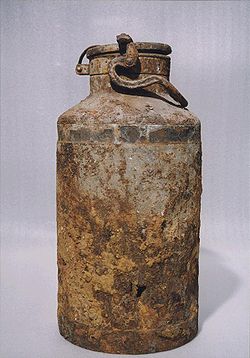
Back Oneg Schabbat German Αρχείο Ρίνγκελμπλουμ Greek Archivo Ringelblum (Oneg Szabat) Spanish بایگانی رینگلبلوم Persian Oyneg Shabbos French עונג שבת (ארכיון) HE Oneg Shabbat Italian Oneg Szabat Polish Онег Шабат Russian Архів Рінґельблюма Ukrainian
| Compiled by Oyneg Shabbos group | |
 One of the milk cans used to hide documents. From the Ringelblum "Oyneg Shabbos" Archive
|
The Ringelblum Archive is a collection of documents from the World War II Warsaw Ghetto, collected and preserved by a group known by the codename Oyneg Shabbos (in Modern Israeli Hebrew, Oneg Shabbat; Hebrew: עונג שבת), led by Jewish historian Emanuel Ringelblum. The group, which included historians, writers, rabbis, and social workers, was dedicated to chronicling life in the Ghetto during the German occupation. They worked as a team, collecting documents and soliciting testimonies and reports from dozens of volunteers of all ages. The materials submitted included essays, diaries, drawings, wall posters, and other materials describing life in the Ghetto. The archive assembly began in September 1939 and ended in January 1943; the material was buried in the ghetto in three caches.
After the war, two of the three caches were recovered and today the re-discovered archive, containing about 6,000 documents (some 35,000 pages),[1] is preserved in the Jewish Historical Institute, Warsaw.[2]
- ^ a b Robert Moses Shapiro; Tadeusz Epsztein, eds. (2009). The Warsaw Ghetto Oyneg Shabes—Ringelblum Archive. Catalog and Guide. Introduction by Samuel D. Kassow. Indiana University Press in association with USHMMM and the Jewish Historical Institute. ISBN 978-0-253-35327-6 – via Academic Publications of the United States Holocaust Memorial Museum.
- ^ Emanuel Ringelblum: The Creator of “Oneg Shabbat” Holocaust Research Project.